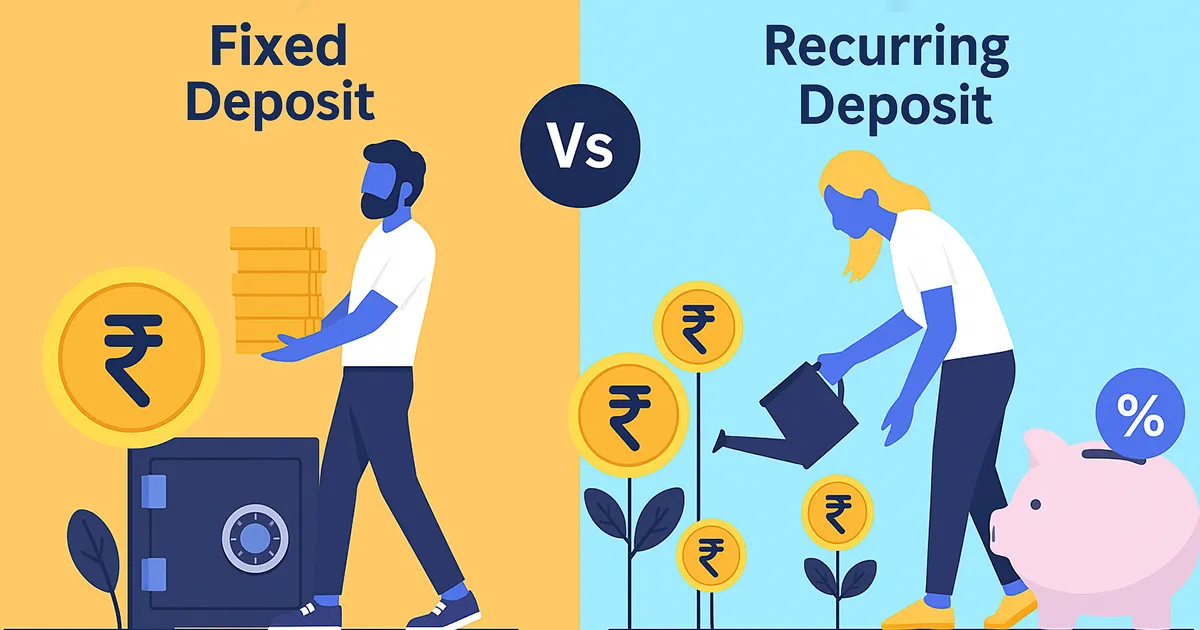
The question comes up often: is one bank account enough, or should you have several? The way people handle their money today is very different from how it was even a few years ago. With digital banking, instant transfers, multiple payment apps, and auto-debits, many people are reconsidering how they structure their bank accounts.
The answer isn’t the same for everyone. Some people do well with just one account, while others find multiple accounts make their financial life more organized, safe, and efficient.
In this article, we’ll break it down in simple terms, look at different situations, and help you decide how many bank accounts you actually need.
1. What Are Fixed Deposits (FDs)?
2. What Are Recurring Deposits (RDs)?
3. How FDs Work for Long-Term Goals
4. How RDs Work for Long-Term Goals
5. Comparing RD and FD Interest Rates
6. Tax Impact on RD and FD Returns
7. Liquidity & Flexibility Differences
8. Who Should Choose FD for Long-Term?
With Fixed Deposits, you deposit a single large amount upfront and let it grow over a set period. The bank locks that amount and pays you a pre-decided interest rate. Keeping your money invested for a longer period allows it to generate higher overall returns due to compounding.
At the end of the chosen period (called the maturity), you receive your principal plus interest.
FDs work well for people who have surplus money available upfront and want to earn steady returns without taking any risks. It’s one of the safest ways to park money in India, especially for long-term financial goals like buying a house, funding a child’s education, or planning for retirement.
A Recurring Deposit (RD) is like building your savings step by step. Instead of putting in a large amount all at once, you deposit a fixed sum every month. The bank adds interest on the total, and over time, your savings grow steadily.
You can select the RD duration, which typically runs from a few months to several years based on the bank’s options. Once the period ends, you get back your total deposits plus the interest earned.
RDs are useful for people who have a regular income but may not have a lump sum ready to invest right away. It’s a disciplined way to build a habit of saving while earning guaranteed returns.
Fixed Deposits work differently when it comes to saving for the long term. You commit a lump sum right from the beginning and let it grow quietly over the years.
Here’s what makes FDs suitable for long-term financial planning:
For people who have received a bonus, inheritance, or have saved up a big sum, FDs allow them to invest it right away and maximize returns over time without worrying about regular contributions.
If you want to build your savings slowly over time, Recurring Deposits offer a simple and steady path. Here’s why:
For long-term goals, RDs allow you to stay committed to saving even if your income is limited or your expenses vary month to month. You don’t feel the pressure of setting aside a large chunk of money at once, but you still move closer to your goal steadily.
While RD is a safe and disciplined way to save for long-term goals, many investors also consider SIPs (Systematic Investment Plans) for building wealth over time with the power of compounding.
If you’re not familiar with how SIPs work, we’ve broken it down in simple terms here: Beginner’s Guide to SIP (Systematic Investment Plan) for Long-Term Wealth.
When it comes to long-term savings, the interest rate plays a major role in how much your money grows.
In general, RD and FD interest rates remain close to each other. However, in most cases, FDs slightly edge ahead — especially for longer tenures. Since you deposit the full amount upfront in an FD, the entire sum starts earning interest right away, allowing the compounding effect to work faster and stronger.
In RDs, only the monthly contributions earn interest as they accumulate. So while you are building up your savings month by month, the interest applies gradually on growing balances.
For long-term goals of 5 years or more, even a small difference in interest rates can add up. This is where FDs often give better total returns, assuming you have the lump sum available to invest at the beginning.
Both RDs and FDs are fully taxable under the income tax rules in India. The interest you earn from either will be added to your total income and taxed according to your applicable slab rate.
Here’s what you should know:
For long-term planning, always look at the post-tax returns while comparing RD vs FD.
Tax rules on interest earned from FD and RD can significantly impact your final returns, especially if you’re in a higher tax bracket.
To help you fully understand how taxes work on these deposits, we’ve explained everything here: Tax on FD and RD Interest: What You Must Know.
Liquidity refers to how quickly you can access your money before the maturity period ends.
In general, FDs are slightly less flexible since your entire amount is locked upfront, while RDs offer a bit more breathing room if your financial situation changes along the way.
For long-term goals where you’re confident about not touching the money, FDs offer better stability. But if you want some flexibility as your income and expenses evolve, RDs provide a softer cushion.
Fixed Deposits are often the first choice for long-term savers who:
FDs suit people who value stability and predictability over higher returns. For conservative investors, especially retirees or those close to retirement, FDs continue to be a reliable tool to protect capital while earning steady income.
RDs make sense for long-term saving if:
Many salaried employees, young professionals, and first-time savers prefer RDs for long-term planning because it allows them to start small and scale up as they progress.
However, if you’re comfortable with a little bit of market risk and have a longer time horizon, you may also consider starting a Systematic Investment Plan (SIP) in mutual funds instead of an RD. Over the long run, SIPs may deliver better returns than regular bank deposits, but they also involve some market risk. It’s a good idea to understand both options carefully before deciding.
Choosing between a Recurring Deposit and a Fixed Deposit depends on your financial situation. If you already have a lump sum ready, Fixed Deposits are usually better for long-term goals since your money starts earning interest immediately, helping you build a larger corpus over time.
However, if you’re still in the process of saving, Recurring Deposits are a great way to stay consistent. They allow you to build your savings gradually without needing a large amount upfront, while still earning steady, guaranteed returns along the way.
For true long-term wealth building, especially beyond 5 years, you may also consider diversifying a portion into mutual funds through SIPs. While they come with market risks, they often provide better growth potential over longer periods. In the end, the best option is the one that fits your income, savings ability, and comfort with risk.
Share with like-minded people!
Lorem Ipsum is simply dumy text of the printing typesetting industry lorem.

Marketing your cloud kitchen isn't just about discounts. This guide shows you how to build brand visibility, attract loyal customers, and drive consistent growth even in competitive delivery markets.

Before your cloud kitchen starts taking orders, you need more than just great food. This complete legal and financial checklist helps you secure licenses, handle taxes, set up accounts, and avoid the most common mistakes that cause new kitchens to fail.

Starting a microgreens business? Don’t repeat the usual mistakes. This guide reveals why many fail—and what you can do differently to succeed.

Starting a microgreens business? Don’t repeat the usual mistakes. This guide reveals why many fail—and what you can do differently to succeed.

Starting a microgreens business? Don’t repeat the usual mistakes. This guide reveals why many fail—and what you can do differently to succeed.

Starting a microgreens business? Don’t repeat the usual mistakes. This guide reveals why many fail—and what you can do differently to succeed.